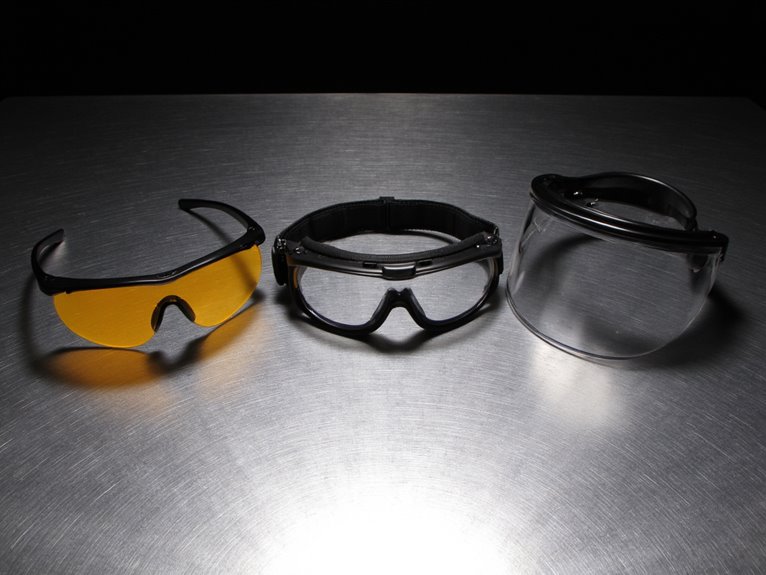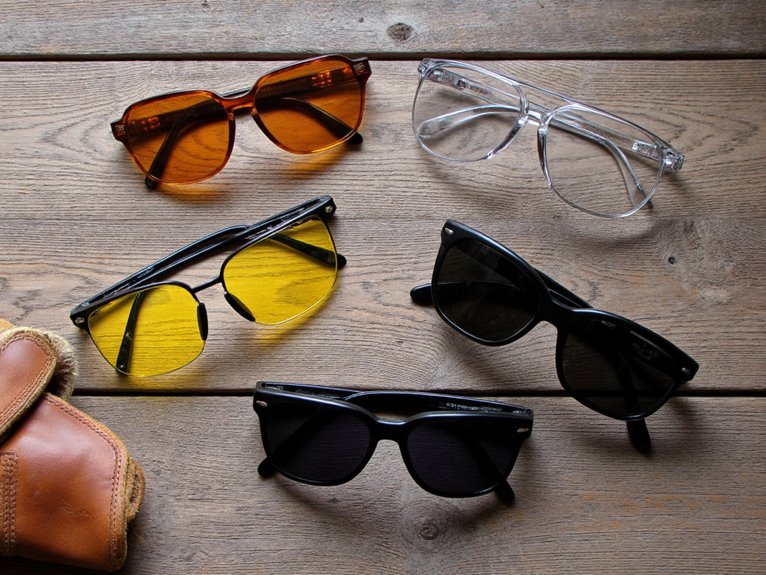How to Pick the Right Eye Protection for Different Shooting Sports
You’ll need ANSI Z87.1+ certified eyewear with polycarbonate lenses for all shooting sports, as they withstand 150 ft/s steel ball impacts and block 100% UV rays. Choose clear or yellow lenses for indoor shooting, amber for hunting in variable light, and gray for bright outdoor conditions. Wrap-around frames prevent peripheral debris while maintaining compatibility with hearing protection. Tactical applications require anti-fog coatings and ballistic resistance, while precision shooting demands minimal optical distortion. Different disciplines have specific requirements that optimize your performance and safety.
We are supported by our audience. When you purchase through links on our site, we may earn an affiliate commission, at no extra cost for you. Learn more. Last update on 26th December 2025 / Images from Amazon Product Advertising API.
Notable Insights
- Choose ANSI Z87.1+ certified polycarbonate lenses with minimum 2mm thickness for impact resistance against projectiles and debris.
- Select lens colors based on environment: clear/yellow for indoor shooting, gray/amber for bright outdoor conditions, brown/copper for variable light.
- Ensure proper fit with lightweight frames under 1.5 ounces and adjustable components to prevent shifting during recoil.
- Use shooting glasses for clean ranges, goggles for dusty outdoor conditions, and face shields for explosive debris protection.
- Consider advanced features like anti-fog coatings, interchangeable lens systems, or photochromic technology for varying light conditions.
Understanding Lens Materials and Safety Standards for Maximum Protection
When selecting eye protection for shooting sports, your lens material choice directly impacts both safety performance and visual clarity during extended range sessions.
Polycarbonate dominates lens manufacturing for shooting eyewear due to exceptional impact resistance—withstanding baseballs at 94 mph speeds. This material blocks 100% of UV rays up to 400nm while maintaining good optical quality.
Polycarbonate lenses deliver exceptional impact resistance and complete UV protection while maintaining superior optical quality for shooting sports.
Nylon offers superior optical clarity through higher Abbe values but costs up to three times more than polycarbonate.
Glass provides excellent clarity but shatters dangerously upon impact. Standard plastic (CR-39) fails at 40-55 mph impacts, making it unsuitable for shooting environments.
Always verify ANSI/ISEA Z87.1 compliance before purchasing. The Z87+ marking indicates proper impact-resistance testing for high-risk activities like firearms use, ensuring your eyewear meets minimum safety requirements for projectile impacts. Consider lenses with a minimum 2mm thickness for enhanced durability during intensive shooting activities.
For optimal protection, choose eyewear with wraparound designs that provide comprehensive side protection and minimize the risk of debris entering between the lens and face.
Coverage Options: Glasses, Goggles, and Face Shields for Different Environments

Beyond selecting proper lens materials that meet safety standards, you’ll need to determine the appropriate coverage level for your specific shooting environment.
A coverage comparison reveals distinct differences between protection types.
Shooting glasses provide basic eye coverage, protecting primarily against shell casings and minor debris in controlled indoor ranges. Goggles create a tighter seal around your eyes, making them ideal for outdoor tactical scenarios where dust and powder residue pose threats.
Face shields offer the most extensive protection, covering your entire face against explosive debris and chemical splashes during reloading or military training.
Environmental hazards dictate your choice: glasses work well in clean settings, while goggles handle dusty conditions, and face shields protect against severe exposure risks. The lightweight design of shooting glasses makes them particularly comfortable for extended shooting sessions where prolonged wear is necessary. Polycarbonate lenses are recommended for all shooting sports due to their superior impact resistance and shatterproof properties.
Achieving Proper Fit and Comfort for Extended Shooting Sessions
When you’re spending hours at the range, your shooting glasses must fit securely without creating pressure points that’ll distract you from your target.
A snug fit prevents the eyewear from shifting during recoil or rapid head movements, which can expose your eyes to debris or compromise your sight picture.
Lightweight frames weighing under 1.5 ounces reduce fatigue and eliminate the heavy feeling that makes you want to remove your protection mid-session.
Snug Fit Prevention Methods
Eyewear slippage during shooting sessions creates dangerous gaps in protection and disrupts your sight picture alignment. Proper nose piece adjustment prevents this critical safety issue. Loosen adjustment screws to shape nose pieces according to your individual contours. Balance snugness on both sides for firm gripping without pressure points.
Temple arm customization guarantees secure positioning against your head. Gently bend arms to eliminate gaps while avoiding excessive pressure. Temple length must provide adequate coverage and firm hold during movement.
Monitor for red marks, sliding, or discomfort indicating poor fit. Use soft silicone nose pads and cushioned temple tips to prevent irritation.
Regular inspection catches loose screws and frame misalignment early. Professional fitting services optimize adjustments when needed, guaranteeing consistent protection throughout extended shooting sessions.
Lightweight Design Benefits
Frame weight plays a crucial role in shooting comfort and performance during extended sessions.
You’ll experience markedly less fatigue when your eyewear weighs under 30 grams compared to heavier alternatives that exceed 50 grams. Polycarbonate lenses reduce lens weight by 40% versus glass while maintaining impact resistance exceeding ANSI Z87.1+ standards.
Proper frame balance distributes weight evenly across contact points, preventing pressure buildup on your nose bridge and temples.
Lightweight nylon blends flex to accommodate various face shapes without adding bulk. Adjustable nose pads made from silicone reduce hot spots during prolonged wear.
You’ll maintain sharper focus when lightweight frames stay positioned correctly throughout rapid movements. Enhanced ventilation channels prevent heat buildup, while anti-slip coatings guarantee stability without excessive tightness during multi-hour shooting sessions.
Selecting Lens Colors and Tints for Optimal Visibility
The lens color you select directly impacts your shooting performance by controlling how light enters your eyes and affects target visibility. Different tints optimize vision under specific lighting conditions while maintaining accurate color perception and lens durability.
| Lighting Condition | Recommended Lens Color | Key Benefits |
|---|---|---|
| Indoor/Low-Light | Clear or Yellow | Maximum light transmission, enhanced contrast |
| Bright Sunlight | Gray or Amber | Reduced glare, true color balance |
| Variable Conditions | Brown or Copper | Improved depth perception, blue light filtering |
Clear lenses provide unaltered vision indoors but lack UV protection. Yellow tints enhance contrast by filtering blue light, improving target distinction in dim environments. Gray lenses reduce overall brightness while preserving natural colors outdoors. Amber and copper options boost contrast and depth perception under bright, variable lighting conditions.
Advanced Features That Enhance Performance and Adaptability
Modern shooting glasses incorporate sophisticated technologies that adapt to changing conditions and maintain peak performance throughout your session.
Anti-fog coatings use hydrophilic treatments to disperse moisture and prevent vision obstruction during temperature fluctuations or high-intensity activities.
Interchangeable lens systems and photochromic materials automatically adjust to light variations, while self-regulating tint functions respond to UV levels without requiring manual intervention.
Anti-Fog Coating Technology
Advanced anti-fog coating technology represents one of the most critical features for maintaining clear vision during shooting sports activities.
Premium coatings like Zeiss and Edge Eyewear’s Vapor Shield deliver superior anti fog effectiveness compared to traditional spray treatments. These embedded coatings maintain clarity across extreme temperatures from -44°F to 125°F and humidity levels up to 80%.
Key performance advantages include:
- Temperature resistance – Military-grade coatings withstand thermal cycling without degradation
- Durability – Embedded surface treatments survive repeated lens cleaning and field use
- Maintenance simplicity – Proper cleaning preserves coating integrity indefinitely
Unlike topical anti-fog films that wear off quickly, advanced coatings integrate directly into polycarbonate and Trivex lens surfaces.
This technology prevents vision distortion during target acquisition while reducing eye strain in prolonged shooting sessions.
Interchangeable Lens Systems
When shooting conditions change rapidly throughout the day, interchangeable lens systems provide the tactical advantage you need without carrying multiple pairs of eyewear.
High-energy magnetic attachments enable fast and secure lens swaps without frame bending or flexing. This lens swap convenience optimizes your adaptability during variable shooting conditions.
Most systems include clear, yellow, smoke, and red lens options.
Yellow lenses enhance contrast in low-light conditions, while smoke lenses reduce glare outdoors. Clear lenses provide baseline protection for indoor shooting.
Quality models comply with ANSI Z87+ standards, with tactical variants meeting dual certifications including MIL-PRF-32432A.
One-touch mechanisms support effortless changes between lens colors.
Rugged frame construction withstands repeated swaps without compromising integrity. Non-slip rubberized components maintain stability during rapid movement and lens exchanges.
Self-Regulating Tint Functions
Beyond manual lens swapping systems, self-regulating tint technology represents the pinnacle of adaptive eye protection for shooting sports.
You’ll encounter two primary technologies: photochromic lenses and electronic LCD systems.
Photochromic advantages include automatic shifts from 75% to 17% visible light transmission within 30 seconds. These lenses respond to UV intensity without manual intervention, maintaining ANSI Z87+ impact resistance throughout the process.
Electronic adaptability offers superior control through LCD technology. Systems like Beretta’s BPT e-Tint provide instant manual activation plus automatic light sensor adjustments. If electronics fail, lenses default to clear state.
Key performance benefits include:
- Enhanced contrast and glare reduction for improved target visibility
- Seamless indoor-outdoor changes without eyewear alterations
- Fail-safe mechanisms ensuring continuous eye protection
Both technologies optimize shooting performance while eliminating vision compromises during environmental changes.
Eye Protection Requirements for Pistol and Competitive Shooting
Since pistol and competitive shooting environments expose your eyes to high-velocity fragments, brass casings, and ricocheting debris, proper eye protection isn’t optional—it’s mandatory safety equipment that can prevent permanent vision loss.
Your eyewear must meet ANSI Z87.1+ certification for high-impact resistance. This standard guarantees lenses withstand a 0.25-inch steel ball traveling at 150 ft/s. Military ballistic standards like MIL-PRF-32432 require even greater protection, resisting 3.8mm projectiles at 195 m/s.
ANSI Z87.1+ certification ensures your shooting glasses can withstand high-velocity impacts that could otherwise cause permanent eye damage.
Eye injury prevention depends on wrap-around designs that block peripheral debris. Choose lightweight frames with anti-fog coatings to maintain clear vision during rapid-fire sequences.
Clear lenses work best for indoor ranges, while amber enhances contrast outdoors. Confirm compatibility with hearing protection for simultaneous use without discomfort or gaps in coverage.
Models like the Smith & Wesson M&P Thunderbolt feature ballistic-rated design with adjustable nose pieces and anti-scratch coatings for enhanced durability during competitive shooting.
Specialized Eyewear for Tactical, Hunting, and Long-Range Applications
Each shooting discipline presents distinct visual challenges that require specialized eyewear solutions beyond basic impact protection.
Your tactical eyewear features must prioritize durability with enhanced ballistic resistance and interchangeable lenses for varied lighting conditions. Anti-fog coatings and splash resistance become critical during high-mobility operations where environmental factors change rapidly.
For hunting applications, your hunting eyewear considerations focus on polarized or amber lenses that reduce glare and enhance contrast. Long exposure to UV radiation demands 400 nm protection, while scratch-resistant coatings withstand brush contact.
Long-range shooting demands exceptional optical clarity with minimal chromatic aberration. Consider these lens specifications:
- Yellow/amber tinting for low-light contrast enhancement
- Anti-reflective coatings to reduce glare and eye fatigue
- Distortion-free optics to maintain target accuracy at distance
On a final note
You’ve now got the technical knowledge to select proper eye protection for your shooting discipline. Match lens materials to your sport’s impact requirements. Choose coverage styles based on your shooting environment. Ascertain proper fit with adjustable features for comfort during extended sessions. Select appropriate lens tints for your lighting conditions. Consider advanced features that enhance performance. Remember that quality eye protection isn’t optional—it’s essential equipment that’ll preserve your vision throughout your shooting career.

